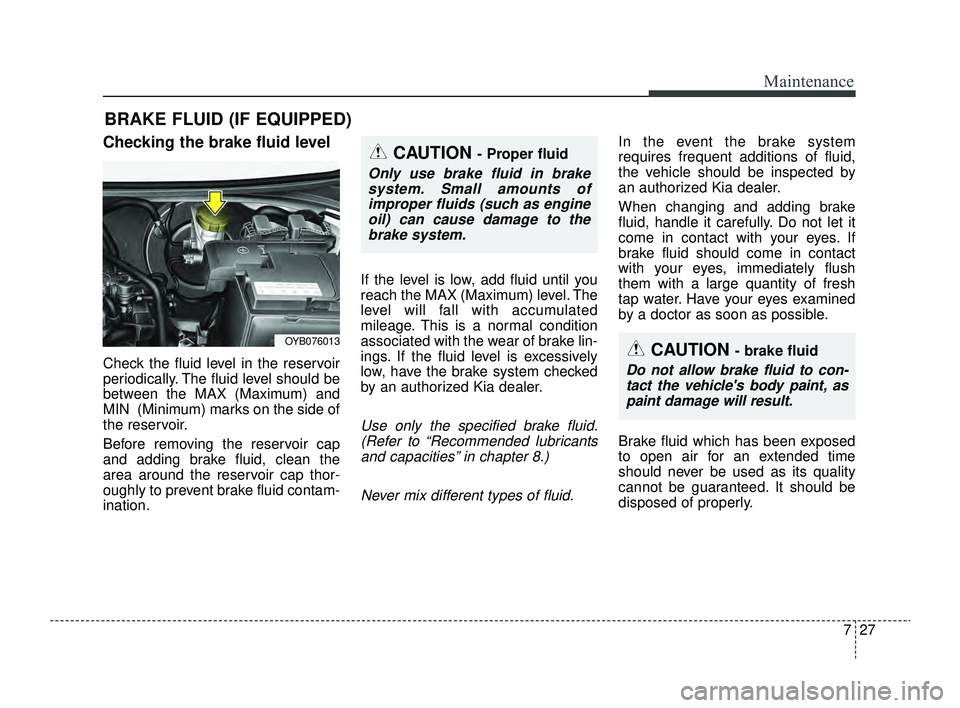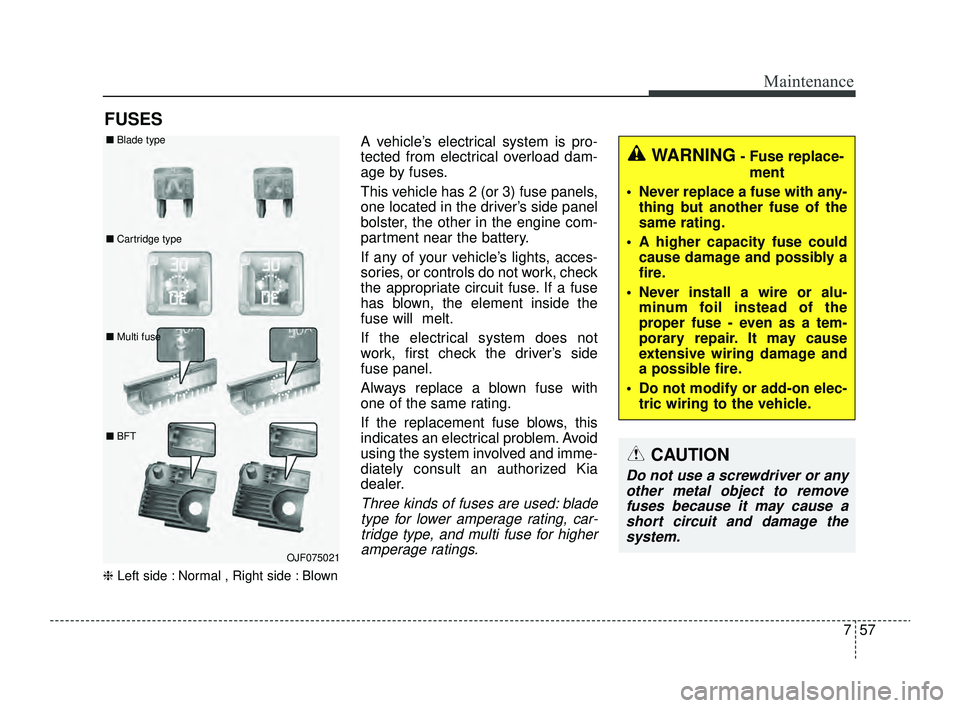2022 KIA RIO check oil
[x] Cancel search: check oilPage 414 of 528

727
Maintenance
BRAKE FLUID (IF EQUIPPED)
Checking the brake fluid level
Check the fluid level in the reservoir
periodically. The fluid level should be
between the MAX (Maximum) and
MIN (Minimum) marks on the side of
the reservoir.
Before removing the reservoir cap
and adding brake fluid, clean the
area around the reservoir cap thor-
oughly to prevent brake fluid contam-
ination.If the level is low, add fluid until you
reach the MAX (Maximum) level. The
level will fall with accumulated
mileage. This is a normal condition
associated with the wear of brake lin-
ings. If the fluid level is excessively
low, have the brake system checked
by an authorized Kia dealer.
Use only the specified brake fluid.
(Refer to “Recommended lubricantsand capacities” in chapter 8.)
Never mix different types of fluid.
In the event the brake system
requires frequent additions of fluid,
the vehicle should be inspected by
an authorized Kia dealer.
When changing and adding brake
fluid, handle it carefully. Do not let it
come in contact with your eyes. If
brake fluid should come in contact
with your eyes, immediately flush
them with a large quantity of fresh
tap water. Have your eyes examined
by a doctor as soon as possible.
Brake fluid which has been exposed
to open air for an extended time
should never be used as its quality
cannot be guaranteed. It should be
disposed of properly.
OYB076013CAUTION - brake fluid
Do not allow brake fluid to con-tact the vehicle's body paint, aspaint damage will result.
CAUTION - Proper fluid
Only use brake fluid in brakesystem. Small amounts ofimproper fluids (such as engineoil) can cause damage to thebrake system.
SC PE USA 7.qxp 9/9/2021 6:27 PM Page 27
Page 428 of 528

741
Maintenance
When recharging the battery,
observe the following precautions:
The battery must be removed fromthe vehicle and placed in an area
with good ventilation.
Do not allow cigarettes, sparks, or flame near the battery.
Watch the battery during charging, and stop or reduce the charging
rate if the battery cells begin
gassing (boiling) violently or if the
temperature of the electrolyte of
any cell exceeds 120°F (49°C).
Wear eye protection when check- ing the battery during charging.
Disconnect the battery charger in the following order.
1. Turn off the battery charger main switch.
2. Unhook the negative clamp from the negative battery terminal.
3. Unhook the positive clamp from the positive battery terminal. Before performing maintenance or
recharging the battery, turn off all
accessories and stop the engine.
The negative battery cable must be removed first and installed last
when the battery is disconnected.Reset items
The following items should be reset
after the battery has been dis-
charged or the battery has been dis-
connected.
Auto up/down window
Sunroof
Trip computer
Climate control system
CAUTION - AGM battery
Absorbent Glass Mat (AGM) batteries are maintenance freeand have the AGM batteryserviced by a professionalworkshop. Kia recommends tovisit an authorized Kia dealer.
For charging your AGM battery,use only fully automatic batterychargers that are speciallydeveloped for AGM batteries.
When replacing the AGM bat- tery, use parts for replacementfrom a professional workshop.Kia recommends to visit anauthorized Kia dealer.
Do not open or remove the cap on top of the battery. This maycause leaks of internal elec-trolyte that could result insevere injury.
SC PE USA 7.qxp 9/9/2021 6:27 PM Page 41
Page 444 of 528

757
Maintenance
FUSES
❈Left side : Normal , Right side : Blown
A vehicle’s electrical system is pro-
tected from electrical overload dam-
age by fuses.
This vehicle has 2 (or 3) fuse panels,
one located in the driver’s side panel
bolster, the other in the engine com-
partment near the battery.
If any of your vehicle’s lights, acces-
sories, or controls do not work, check
the appropriate circuit fuse. If a fuse
has blown, the element inside the
fuse will melt.
If the electrical system does not
work, first check the driver’s side
fuse panel.
Always replace a blown fuse with
one of the same rating.
If the replacement fuse blows, this
indicates an electrical problem. Avoid
using the system involved and imme-
diately consult an authorized Kia
dealer.
Three kinds of fuses are used: blade
type for lower amperage rating, car-tridge type, and multi fuse for higheramperage ratings.
WARNING- Fuse replace-
ment
Never replace a fuse with any- thing but another fuse of the
same rating.
A higher capacity fuse could cause damage and possibly a
fire.
Never install a wire or alu- minum foil instead of the
proper fuse - even as a tem-
porary repair. It may cause
extensive wiring damage and
a possible fire.
Do not modify or add-on elec- tric wiring to the vehicle.
CAUTION
Do not use a screwdriver or anyother metal object to removefuses because it may cause ashort circuit and damage thesystem.
OJF075021
■
Blade type
■ Cartridge type
■ Multi fuse
■ BFT
SC PE USA 7.qxp 9/9/2021 6:27 PM Page 57
Page 520 of 528

Index
4I
Emission control system ..............................................7-111Crankcase emission control system ..........................7-111
Evaporative emission control (including ORVR: Onboard Refueling Vapor Recovery) system ........7-111
Exhaust emission control system ..............................7-112
Engine .................................................................\
...........8-2
Engine compartment ................................................2-7, 7-4
Engine coolant ..............................................................7-24 Changing the coolant ..................................................7-26
Checking the coolant level..........................................7-24\
Engine number ..............................................................8-10
Engine oil ......................................................................7-\
21 Changing the engine oil and filter ..............................7-22
Checking the engine oil level ....................................7-21
ENGINE START/STOP button ....................................5-10 ENGINE START/STOP button position ....................5-10
Illuminated ENGINE START/STOP button ..............5-10
Starting the engine ......................................................5-13
Explanation of scheduled maintenance items ..............7-15
Exterior overview ............................................................2-2
Forward Collision-Avoidance Assist (FCA)..................5-41 Brake operation ..........................................................5-46
Detecting sensor ..........................................................5-41
Forward Collision-Avoidance Assist malfunction ......5-48
Forward Collision-Avoidance Assist settings ............5-42 Forward Collision-Avoidance Assist warning message
and function control ..................................................5-44
Limitations of Forward Collision-Avoidance Assist ..5-50
Warning message and warning light ..........................5-47
Fuel filler door ..............................................................4-42 Closing the fuel filler door..........................................4-\
43
Opening the fuel filler door ........................................4-42
Fuel requirements ............................................................1-3 Do not use methanol ....................................................1-4
Gasoline containing alcohol and methanol ..................1-3
Fuses ........................................................................\
......7-57 Engine compartment fuse replacement ......................7-61
Fuse/relay panel description ......................................7-63
Inner panel fuse replacement ......................................7-59
Memory fuse ..............................................................7-60
Hood ........................................................................\
......4-39 Closing the hood ........................................................4-40
Hood open warning ....................................................4-40
Opening the hood ......................................................4-39
How to use this manual ..................................................1-2
F
H
SC PE USA Index.qxp 8/23/2021 5:25 PM Page 4
Page 526 of 528

Index
10I
Wheel alignment and tire balance ............................7-45
Wheel replacement ....................................................7-47
Towing ........................................................................\
..6-29 Emergency towing ......................................................6-31
Removable towing hook (front)..................................6-30
Towing service ............................................................6-29
Trip computer ................................................................4-58 Service Mode (For type A cluster)..............................4-63
Trip information (Trip computer) ..............................4-58
Trunk (For 4 door) ........................................................4-24 Closing the trunk ........................................................4-24
Emergency trunk safety release ..................................4-25
Opening the trunk ......................................................4-24
Vehicle break-in process ..................................................1-5
Vehicle certification label ................................................8-9
Vehicle data collection and event data recorders ............1-6
Vehicle Identification Number (VIN)..............................8-9
Vehicle load limit ........................................................5-115 Certification label......................................................5-118
Tire and loading information label ..........................5-115
Vehicle modifications ......................................................1-5
Vehicle weight ............................................................5-120 Base curb weight ......................................................5\
-120
Cargo weight ............................................................5-120
GAW (Gross axle weight) ........................................5-120 GAWR (Gross axle weight rating) ..........................5-120
GVW (Gross vehicle weight) ..................................5-120
GVWR (Gross vehicle weight rating) ......................5-120
Vehicle curb weight ..................................................5-120
Warning and indicator lights..........................................4-78 Indicator Lights ..........................................................4-86
Warning lights ............................................................4-78
Washer fluid ..................................................................7-29 Checking the washer fluid level ..............................7-29
Weight/Volume ................................................................8-6
Windows ........................................................................\
4-33 Power windows ..........................................................4-34
Windshield defrosting and defogging..........................4-135 Automatic climate control system ............................4-136
Defogging logic ........................................................4-137
Manual climate control system ................................4-135
Winter driving ..............................................................5-110 Carry emergency equipment ....................................5-114
Change to "winter weight" oil if necessary ..............5-113
Check battery and cables ..........................................5-112
Check spark plugs and ignition system ....................5-113
Don't let ice and snow accumulate underneath ........5-113
Don't let your parking brake freeze ..........................5-113
Snowy or Icy conditions ..........................................5-110
To keep locks from freezing ....................................5-113
W
V
SC PE USA Index.qxp 8/23/2021 5:25 PM Page 10